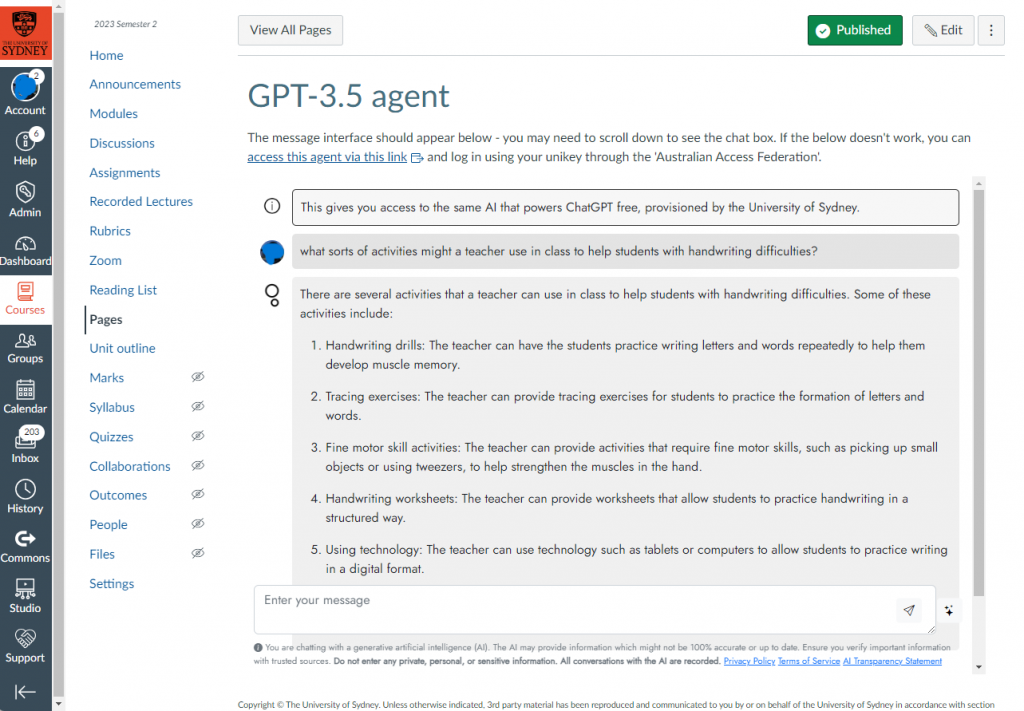Mrs S is the brainchild of Joanne Hinitt and Kria Coleman from the University of Sydney. Joanne teaches into a second-year unit where occupational therapy students learn how to collaborate with teachers in inclusive education contexts to enhance participation in school activities. In this unit, Joanne used Cogniti in two ways to help her students’ learning.
Here we cover some of the AI elements of how Joanne used Cogniti; you should also check out how Joanne and Kria designed the educational elements around generative AI to support student learning.
A safe, private ChatGPT
When Joanne surveyed her students ahead of time, many said that they had not used ChatGPT because they didn’t want to create their own accounts or were concerned about privacy. Using Cogniti, Joanne was able to create a ‘vanilla GPT-3.5’ agent that she was able to provide to students. Because access to Cogniti is provisioned through the institution and accessed through an LTI plugin in Canvas, students did not need to create their own accounts and could easily access a plain ChatGPT-like interface powered by the same AI engine that is available through the free ChatGPT.

A steered, resourced agent acting as ‘Mrs S’
The most impactful part of the class was when Joanne’s occupational therapy students interacted with ‘Mrs S’, a Cogniti agent that had been trained and resourced to act as a kindergarten teacher. By building a system prompt that instructed the Cogniti agent to act as a busy teacher who was mindful of inclusive teaching and the pressures facing classroom teachers, Mrs S could interact with Joanne’s students in a realistic way. The agent was also given examples of pushbacks (such as jargon, ideas without rationale, unrealistic proposals, etc) and a range of contextual considerations. Building this in Cogniti also allowed Joanne to provide the Mrs S agent with a resource around inclusive teaching, so that Mrs S had access to key guidelines.
In the classroom activity, Joanne’s occupational therapy students worked in groups to develop an intervention plan for Mrs S’ class, using the vanilla ChatGPT as an assistant. Then, they finessed these plans and presented these to Mrs S. Joanne noted that the class was buzzing and that, walking around her classroom, she was able to engage many more students in deeper questions around occupational therapy practice compared to a traditional class session. Joanne also noted that her students were encouraged to develop much higher order thinking skills compared to standard activities. After the class, students told Joanne that it was a great way to practice talking with clients, and encouraging them to articulate their reasoning to improve their intervention plans.

A holistic educational design around generative AI
Joanne and Kria worked together to design a lesson that would introduce generative AI to occupational therapy students in a real world potential use, helping them to practice using it with ethics and professionalism in mind. We’ll have more on this soon, but it’s worth noting that this whole activity was developed within a week and a half before the class. Cogniti provided Joanne with the flexibility to steer her own agents and embed these into Canvas for her students to access easily.
The educational design involved three main steps, and we’ll have more details about this soon:
- Pre-work introducing students to generative AI.
- In-class intervention ideation activity using the vanilla ChatGPT. Students were provided basic guidance on how to prompt this generative AI, and worked in groups to design the intervention.
- In-class activity interacting with Mrs S. Groups would collaborate with Mrs S to discuss their proposed intervention.
- Reflection and debrief
Behind the scenes
Cogniti’s ability to be steered and resourced and easily trialed and deployed meant that Joanne and Kria could move quickly from concept to implementation. Part of the system prompt we used is in the screenshot below, and the Mrs S agent used the GPT-4 large language model hosted by Microsoft Azure, making it secure, safe, and private.
